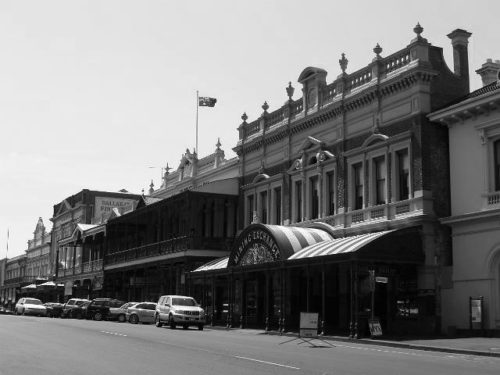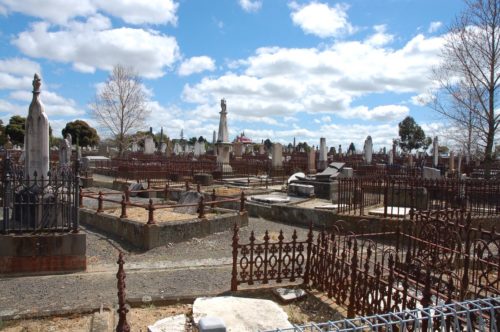AUSTRALIA – An academic has recently pieced together the story of Mary Barrell, which is among the earliest documented cases of Witchcraft and fortune telling in the country. Historian and folklorist Dr David Waldron made the discovery when conducting research in Victorian-era newspapers. He found letters to the editor spanning over three decades.

Front of the historic goldmine Ballarat [freeaussiestock.com]
The Methodist and the Spiritualist
According to a recent article by the Ballarat Courier, the letters published in newspapers complaining about Barrell and her fortune telling were at least in part caused by and demonstrative of ongoing friction between two notable and influential Ballarat pioneers who had very different sensibilities: Wesleyan Methodist and town council member James Oddie and Freemason and Spiritualist James Curtis.
Often referred to as the Father of Ballarat, James Oddie was a staunch Methodist and the first chairman of the Ballarat Municipal Council.
James Curtis established the first printing press on the Ballarat goldfields and was a well-known figure of the time. He was a Freemason and involved with the Spiritualist movement of the time.
“Curtis himself became attracted to Spiritualism after reading of the death of his beloved fiance Annie Beal through a series of letters after arriving in Australia. The grief and sense of hopelessness that came from the experience from reading her slow deterioration months after the fact must have been heartbreaking.” Waldron said.
“His own experiences here in Ballarat were penned in a self-published work, Rustlings of a Golden City.”
“This was a common pattern and looking for ways to grapple with death and the afterlife at a time when traditional Christian eschatology was crumbling under the rise of science, enlightenment secular education and new religious movements.”
Both Oddie and Curtis were on the panel of the Ballarat Benevolent Asylum. Now known as the Queen Elizabeth Centre, the asylum and its committee began in 1857 as a charitable organisation providing accommodation and financial support to those considered to be in need.
Mary Barrell was a recipient of this support, which became a point of contention for conservative committee members such as Oddie.
Ballarat’s fortune teller
Waldron’s research found that Mary Barrell was born in 1819 with the maiden name Rae. She arrived in Melbourne around 1848. She married a man called William Barrell, who, as it seems, abandoned her after their child died; there are records of Barrell pursuing her husband through the courts for child support and later abandonment.
The loss of her child in 1862 and the abandonment by her husband shortly after meant that Barrell was now a woman alone on the Victorian goldfields during the height of the gold rush. This wasa time when populations in small towns soared as tens of thousands flocked to Australia in search of fortune.
It seems that, upon arrival in Ballarat, Barrell set out to earn an income reading fortunes at the Ballarat General Cemetery, which was opposite her home. This was not always well received, as letters start appearing in the local newspapers.
There is at present a woman living on Creswick Rd who calls herself a fortune-teller, going about town persuading (in most cases married) ladies to have their fortunes told them, for which she would receive a guinea upwards. The result of which is that by her misrepresentations many families who have hitherto lived in happiness are compelled to separate and appear before the police court. – Ballarat Star, September 1870
Waldron’s colleague, author and Curator of Federation University’s Art and Historical Collections Clare Gervasoni suggested to him that – considering Barrell’s mostly female clientele – this “fortune telling” may have included words of wisdom on issues considered taboo at the time, including sexual health, contraception, marriage counselling, or even uncovering information about philandering husbands. Discussing such matters would have ruffled a few feathers within the highly patriarchal Victorian society.
A war of words… and worse
The nature of this work along with the fact that it was conducted in a place of the dead attracted outraged anonymous letters from pseudonyms such as Reckless and Nemesis, coming thick and fast to local newspaper The Ballarat Star. The anonymous writers describe Barrell as a “harridan”, an “old hag,” and a “notorious character.”

Old Ballarat Cemetery [© Film Victoria]
The attacks against Barrell and her business did not stop at the written word. According to Waldron’s research, she was threatened, beaten, and assaulted on more than one occasion. In February 1870, a “rowdy” called John Ryan was charged with making threats against her life. Ryan would go on later to physically assault Barrell, kicking, and punching her – an act for which he would be charged 40 shillings in lieu of 14 days’ gaol. At the time, Barrell was accused of “witchery” and of being a cause of misery.
Spiritualism in the Victorian Era
Waldron said that during this time there was a long tradition of folklore and ritual belief.
“In Australia with its percentage of rural working class Irish and Scottish populations, [this belief] was quite pronounced in the population and less able to be regulated in the manner it was controlled in Britain itself. Another important factor was the multi-cultural nature of the goldfields with large populations of Hindi, Muslims, Chinese and others creating a melting pot of new religious perspectives and beliefs. Intermarriage between people of different faiths and cultures also exacerbated this trend.
“Colonial Victoria was a hotbed for Spiritualism, and seances and performances were a both a common pastime and the basis of a significant religious revival.” Waldron continues.
“There were also displays in Ballarat by popular international spiritualists such as Jesse Shepard, Madam Sibyl, and Henry Slade performed in high profile venues such as Her Majesty’s theatre. There was significant conflict between those who saw spiritualism as a serious practice and those who utilised it for performances.”
Mary Barrell emerges in this context but in a very different way. “Unlike the Spiritualists (Barrell) is from a working class background and is selling charms and cures and practising in the local cemetery. She also has a strong following among women coming to her for medical advice. This puts her in quite a different category than the Spiritualist movement.” Waldron explains.
“She is also not engaging in seances but instead dealing with charms, cures and folk magic, is poor and elderly and likely illiterate, given issues in writing her name. This puts her in quite a different category and practice. This led Professor Owen Davies to be quite sure she was a traditional cunning woman who practiced her as a profession after her separation from her husband following the death of their child.”
The Ballarat Benevolent Asylum
Presumably, Barrell continued to conduct her fortune telling as the letters to the newspaper continued. Soon, minutes of a meeting of the Ballarat Benevolent Asylum were published in the same paper. In these minutes, James Oddie proposed that Mary Barrell no longer receive financial assistance from the asylum unless she ceased her “soothsaying” activities. This would also permit her to live at the asylum.
Curtis once again spoke out in Barrell’s defense, slamming the Star for publishing these minutes and saying of Barrell “I certainly could not blame her for getting a shilling now and then if she could.”
Barrell asked for the asylum financial benefit to be curtailed, as long as she could continue to live peacefully in her home.
Farewelling the fortune teller
Letters were still written to the Star about Barrell as late as 1882 but were published without comment from the newspaper itself. When she died in 1896, a small crowd came to farewell Ballarat’s fortune teller at a funeral paid for by James Curtis. Barrell was buried in the same grave that had been for decades occupied by her infant son, in the same cemetery where she conducted her work.
Dr David Waldron is a regular contributor to the Tales from Rat City podcast. The podcast’s next episode will focus on Mary Barrell, the Fortune-Teller of Ballarat.
The Wild Hunt is not responsible for links to external content.
To join a conversation on this post:
Visit our The Wild Hunt subreddit! Point your favorite browser to https://www.reddit.com/r/The_Wild_Hunt_News/, then click “JOIN”. Make sure to click the bell, too, to be notified of new articles posted to our subreddit.
